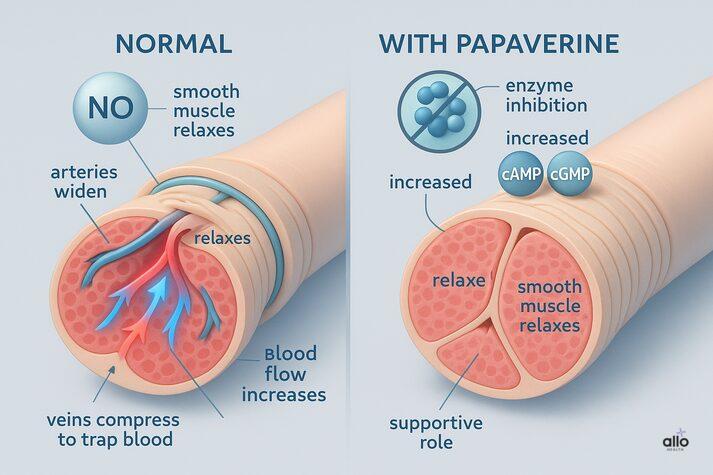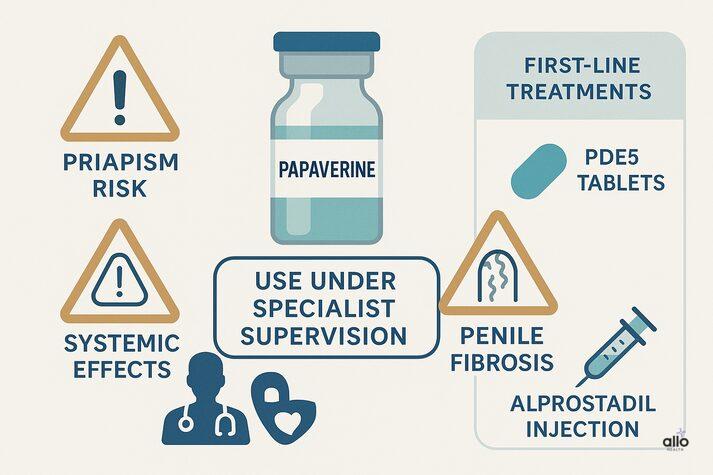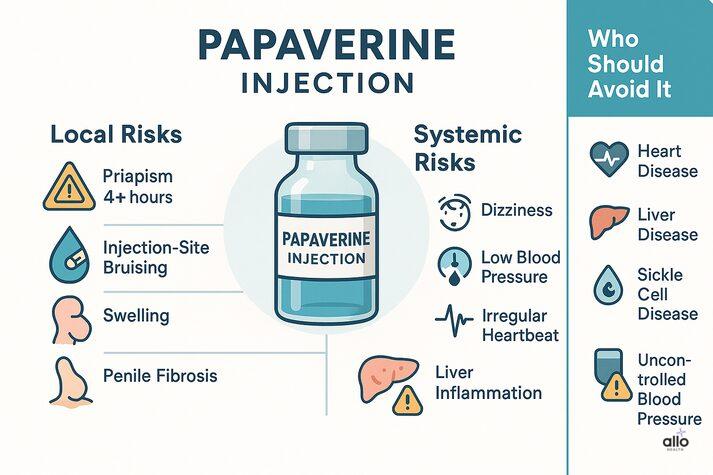Papaverine for Erectile Dysfunction: Use, Dosage, and Side Effects

Papaverine is an older injectable treatment for erectile dysfunction that works by relaxing penile muscles and boosting blood flow, often used when standard ED tablets don’t help. While it can produce strong erections, it carries higher risks, especially priapism and penile scarring, which is why it’s no longer a first-line option. Topical gels are being researched but aren’t reliable yet. If you’re considering papaverine or injections for ED, make sure it’s under a specialist’s guidance. Persistent ED should always be evaluated by a sexual health expert to find the safest and most effective treatment for you.
Erectile dysfunction can feel overwhelming, especially when the usual medications don’t seem to help. That’s often when men start exploring lesser-known treatments, and one name that comes up in many specialist discussions is papaverine. Papaverine has been around for decades, but it continues to play a role in certain complex cases of ED where other options fall short.
Papaverine helped many men by directly improving blood flow to the penis through injection therapy. Even today, it can still be useful for men who don’t respond well to oral ED medicines, particularly those with blood-flow–related or post-surgical erectile problems.
In this article, we’ll take a look at papaverine for erectile dysfunction, how it works, how it’s used, the papaverine dose for erectile dysfunction, possible risks and side effects, and when it might be considered as a treatment option.
What is Papaverine for Erectile Dysfunction?
Papaverine is a medicine that helps relax and widen blood vessels (peripheral vasodilator), which improves blood flow. It can also help relax muscles( smooth muscle relaxant). Even though it originally comes from the opium poppy plant, it is not an opioid and does not behave like drugs such as morphine or heroin. It works completely differently and has no addictive or “drug-like” effects. [1]
Papaverine has been used since the early 1980s to help create an erection through medical means (pharmacologically induced erections) in men suffering from erectile dysfunction[2]. Doctors inject it directly into the spongy erectile tissue of the penis, which helps increase blood flow and produce an erection. This method is known as penile injection therapy.
Historically, papaverine played a big role in:
- Diagnosing ED that is caused by physical issues (organic erectile dysfunction), especially due to problems with the blood vessels (vasculogenic disease)that supply the penis.
- Treating ED in men who couldn’t use or didn’t respond to ED medications like sildenafil citrate (Viagra).
Research has found that papaverine can:
- Help widen the arteries in the penis and improve blood flow. [2]
- Produce firm erections in many men when injected correctly. [2]
- Improve erection-quality scores on medical questionnaires (like the IIEF), especially in men whose ED is linked to blood-flow problems. (vascular factors) [2]
Over time, however, its role has shrunk because:
- The risk of developing priapism (a prolonged, painful erection) and penile fibrosis (scar-like tissue inside the penis) is relatively higher compared to newer drugs. [1]
- Oral medications are easier to use, more acceptable, and generally safer for most men.
- Other injectable agents, particularly prostaglandin E1 (alprostadil), are often preferred. [1]
Today, papaverine is more of a second- or third-line option, used mainly in specialist settings, for complex ED or where standard treatments have failed.

How Does Papaverine for Erectile Dysfunction Work?
To understand papaverine, it helps to understand what happens during a normal erection, briefly:
Upon sexual stimulation:
- Blood vessels in the penis open up
- The muscles in the erectile tissue relax
- Blood fills the spongy tissue (corpus cavernosum) in the penis
- The veins get gently pressed shut, which traps the blood and keeps the erection firm
Papaverine works by directly relaxing these muscles and widening penile blood vessels, thus improving blood flow into the penis. It blocks certain chemicals, called enzymes, inside the penile muscles. When these enzymes are blocked, two natural chemicals (cyclic AMP and cyclic GMP) increase. Higher levels of these chemicals help the muscles in the penis relax. [3]
Once these muscles relax:
- The arteries open wider, bringing more blood into the penis.
- The erectile tissue fills with blood, creating pressure.
- The veins get compressed, so the blood stays trapped.
This results in a firm, long-lasting erection.
Some studies show that papaverine may also work through the body’s natural nitric oxide (NO) system, the same process involved in normal erections. It seems to help the blood vessels relax using a slightly different process than common ED tablets like Viagra, but the result is similar: better blood flow to the penis.
Papaverine may be used for:
- Severe vasculogenic ED where blood flow is significantly impaired.
- ED due to blood vessel issues (vascular disorders) affecting genital blood flow.
- Post-surgical ED (for example, after prostate surgery)
- Cases resistant to oral medication.

Is It Safe to use Papaverine for Erectile Dysfunction?
Papaverine is effective, but it is not a casual or “mild” treatment. It’s usually reserved for men under specialist care (often a urologist) because:
- It has a higher risk of priapism compared to some other agents.
- Long-term use can lead to penile fibrosis, including plaques, nodules, and curvature similar to Peyronie’s disease.
- There is potential for liver damage (hepatotoxic effects) and heart problems with higher systemic exposure, especially when not used as intended.
Modern guidelines generally prefer:
- Oral medications (like sildenafil, tadalafil) as the first-line treatment.
- Alprostadil (PGE1) injections or intraurethral therapy when injections are needed.
- Papaverine is considered more of a backup option when other treatments fail or are contraindicated.
So is it “safe”?
- Under proper medical supervision, with correct dosing, monitoring, and patient education, it can be used.
- Without supervision or self-injection advice from the internet, it can be dangerous.

Papaverine Dose for Erectile Dysfunction
Papaverine is most commonly available as a Papaverine 60 mg Injection (papaverine hydrochloride solution). [3]
It is injected directly into the spongy erection-producing tissue of the penis (an intracavernosal or intracavernous injection).
Doctors usually begin with a low dose of 15–30 mg and slowly adjust it depending on how well the person responds. Some men, especially those with spinal cord injuries, may need much smaller doses, sometimes as low as 5–10 mg. After the injection, the erection usually starts within about 10 minutes and may last 1 to 4 hours. [3]
To keep the treatment safe and reduce complications, specialists advise:
- Not using it more than once a day
- Not using it more than 2–3 times a week
- Lowering the dose if the erection lasts too long
To avoid needles or needle phobia, researchers have explored non-invasive forms like transdermal papaverine [4], which is papaverine that can be applied on the skin (usually as a gel or cream) so it can absorb through the skin into the penis, instead of being injected. Some of these include:
- Papaverine gel
- Topical papaverine gel with 15–20% papaverine base
- Transdermal papaverine using advanced systems like nanostructured liquid crystals. [5]
Studies have shown that these gels can:
- Improve blood flow in the penile arteries during Doppler tests.
- Produce full erections in a small number of men, especially those with spinal cord injuries.
- Cause very few whole-body side effects because very little papaverine enters the bloodstream.
However, these topical forms are still considered experimental and are not as reliable as injections.
Note: Papaverine is not a long-term fix for ED. It is an on-demand treatment, used shortly before planned sexual activity.
Papaverine can be used on its own as a single-drug injection or as part of a combination injection, for example:
- Papaverine + phentolamine
- Papaverine + phentolamine + prostaglandin E1 (trimix therapy)
These combinations can create a stronger and more reliable erection than papaverine alone.

Risks of Using Papaverine for Erectile Dysfunction
Because papaverine acts directly on erectile tissue and blood vessels, it comes with both local and full-body risks.
Local Side Effects (at the injection site)
- Priapism (low-flow priapism): A prolonged erection lasting more than 4 hours.
- Penile pain or burning along the penis.
- Bruising or bleeding at the injection site.
- Swelling.
- Penile fibrosis: Scar-like tissue forming inside the penis. This can create small hard lumps or patches (called nodules or plaques), and over time, it may cause the penis to bend or change shape during an erection.
Regular self-examination of the penis is essential during penile injections. Any lump, persistent pain, or curvature should be reported to a doctor.
Systemic (Full-Body) Side Effects
If too much papaverine enters the bloodstream, it can cause:
- Dizziness, flushing, headache
- Drop in blood pressure (hypotension)
- Irregular heartbeat, especially in those with existing heart problems
- Liver damage/liver inflammation, abnormal liver tests
- Mood changes or severe fatigue
Papaverine may interact with:
- Certain medicines that affect heart rhythm
- Drugs that also cause blood vessel relaxation or lower blood pressure
- Some psychiatric or antidepressant medications
- Herbal supplements like Ginkgo Biloba for ED, which may increase bleeding risk
That’s why it’s important to let your doctor or pharmacist check all your medicines first, to make sure papaverine won’t react badly with anything you’re already taking.
Who Should Avoid Papaverine or Use It with Extreme Caution?
Papaverine may not be suitable for:
- Men with a history of priapism or sickle cell disease
- Those with significant liver disease
- Men with serious cardiovascular disease or unstable blood pressure
- Those with uncontrolled peripheral vascular disease or complex vascular disorders where blood flow regulation is already impaired
- Anyone with a known allergy to papaverine or components of the injection

When To See A Doctor
Erectile dysfunction is not just about sex; it can also be an early sign of blood vessel problems, diabetes, or heart disease.
You should see a doctor or urologist if:
- You frequently struggle to get or keep an erection firm enough for sexual activity.
- The problem has lasted more than 3 months.
- You have other symptoms, such as chest pain, shortness of breath, leg cramps while walking, or a history of vascular factors like high blood pressure, high cholesterol, or diabetes.
- You are considering penile injections (papaverine, alprostadil, tri-mix) and want to know if they’re safe for you.
- You tried papaverine or any ED injection and had an erection lasting more than 4 hours: This is an emergency.
- You notice lumps, nodules, or curvature developing in the penis: These may indicate penile fibrosis or early Peyronie’s disease.
Needle-based treatments sound intimidating, but for the right patient, they can make a real difference. What matters most is getting the dose right and monitoring the response to keep things safe.
Conclusion
Papaverine has played an important role in the early treatment of erectile dysfunction, and it can still produce strong erections in men with complex or blood-flow-related ED. But because it carries a higher risk of priapism and penile scarring, requires careful injections, and has been replaced by safer options like PDE5 tablets and prostaglandin E1, it’s no longer used as a first choice.
Today, it’s mainly reserved for men who don’t respond to standard treatments or need specialised combination injections like tri-mix. If your erectile difficulties continue or don’t improve with basic treatments, it’s best to consult a sexual health expert who can guide you toward the safest and most effective options.
"The following blog article provides general information and insights on various topics. However, it is important to note that the information presented is not intended as professional advice in any specific field or area. The content of this blog is for general educational and informational purposes only.
Book consultation
The content should not be interpreted as endorsement, recommendation, or guarantee of any product, service, or information mentioned. Readers are solely responsible for the decisions and actions they take based on the information provided in this blog. It is essential to exercise individual judgment, critical thinking, and personal responsibility when applying or implementing any information or suggestions discussed in the blog."






